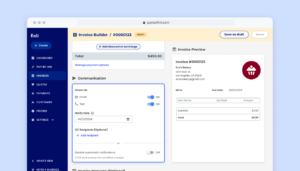What Is a Business Budget?
A business budget is a financial plan outlining expected income and expenses over a specific period. It helps companies allocate resources, assess financial performance, and achieve goals.
By forecasting revenue and planned expenditures, businesses can control spending, prioritize investments, and avoid financial pitfalls.
How to Create a Business Budget for Your Small Business
Creating a business budget is essential for managing your small business’s finances effectively. Here’s a step-by-step guide to help you establish a solid budget:
1. Separate Your Business Finances from Your Personal Finances
Start by opening a business bank account to keep your personal and business finances distinct. This separation simplifies bookkeeping, improves financial tracking, and enhances the professionalism of your business dealings.
Use dedicated business credit cards for any purchases related to your enterprise.
2. Set Aside a Contingency Fund for Emergencies
Allocate a portion of your budget to an emergency fund to handle unforeseen expenses, such as equipment repairs, sudden market downturns, or other financial crises.
This fund acts as a financial cushion, ensuring your business can continue operating smoothly during tough times without tapping into other critical resources.
3. Identify Your Revenue Streams
List all sources of income for your business. This might include sales of products or services, online transactions, or passive income from investments.
Understanding different revenue streams helps you forecast income more accurately and identify areas for growth.
If you are using Finli’s digital payment system, you can easily see your income streams and use this data to create your budget.
4. Determine Your Fixed Costs
Fixed costs are expenses that remain relatively constant each month and do not fluctuate with business activity. These might include rent, salaries, insurance, and loan payments.
You need to accurately identify these costs to form the baseline of your budget.
5. Determine Your Variable Costs
Unlike fixed costs, variable costs change based on business activity. These include material costs, utility expenses, and commissions.
Monitoring these costs is vital for maintaining profitability, especially when business activities fluctuate.
6. Create a Profit and Loss Statement
Compile the information from your revenue streams, fixed costs, and variable costs into a profit and loss statement. This document provides a clear view of your business’s financial health over a specific period.
It outlines total revenue, subtracts total expenses, and shows the net profit or loss. Regularly updating this statement helps you track financial performance and make informed decisions.
By following these steps, as a business owner, you can create a budget that not only keeps your finances in check but also supports strategic decision-making and promotes sustainable growth.
Types of Business Budgets
Master Budget
A master budget combines all of a company’s individual budgets and financial plans into a comprehensive financial planning document. It encompasses the operating budget—which details revenue and expenses from daily operations—and the capital budget, which outlines investments in major physical assets.
The master budget also includes financial budgets like cash flow forecasts and the projected balance sheet. This overarching budget provides a strategic vision for the entire fiscal year, aiding in coordination and financial decision-making, and serves as a benchmark for performance evaluation.
Operating Budget
An operating budget details a company’s projected revenues and expenses over a specific period, usually a fiscal year. It includes all costs associated with running the business, such as salaries, rent, utilities, and materials, against anticipated income.
This budget is vital for day-to-day management, helping businesses plan for profitability by forecasting financial outcomes and controlling expenditures. It serves as a roadmap for operational activities, guiding companies in allocating resources efficiently to maximize financial performance.
Capital Budget
A capital budget focuses on a company’s planned expenditures for major physical assets that are expected to provide benefits over a long period, such as buildings, machinery, and technology. It involves assessing potential investments in capital projects and allocating resources accordingly.
The capital budget helps for strategic planning, helping businesses prioritize and manage large-scale investments based on their potential to boost operational capacity, enhance efficiency, and drive growth.
This budgeting process typically includes evaluating the expected returns and risks associated with each capital project.
Cash Budget or Cash Flow Budget
A cash budget, or cash flow budget, is a detailed plan that predicts a company’s cash inflows and outflows over a specific period, usually monthly or quarterly.
It helps businesses manage their liquidity by forecasting when cash will be received and when expenses will be paid, ensuring there is enough cash on hand to meet financial obligations.
This budget prevents cash shortages, planning for surplus cash investments, and supports operational stability. It assists in making informed decisions about funding, investing, and financing activities.
Labor Budget
A labor budget forecasts the costs associated with a company’s workforce over a specific period, detailing expenses for salaries, wages, benefits, and any additional labor-related costs.
It helps organizations plan and manage the financial impact of their staffing decisions, including hiring, overtime, and shifts in personnel needs.
The labor budget is essential for aligning workforce costs with projected revenues and operational goals, ensuring that staffing levels are appropriate to meet business demands without compromising financial efficiency.
Budgeting Methods You Can Use
Incremental Budgeting
Incremental budgeting is the most straightforward method where the current budget is based on the previous period’s budget with incremental adjustments made for the new period.
This typically involves adding a certain percentage to the previous budget to account for inflation, increased costs, or anticipated revenue growth. The primary advantage of incremental budgeting is its simplicity and ease of implementation, as it does not require a complete overhaul of the existing financial plan.
However, this method can perpetuate previous budgeting errors and may lead to complacency, potentially ignoring shifts in the market or changes in operational efficiency.
Zero-Based Budgeting (ZBB)
Zero-Based Budgeting starts from a “zero base,” with every expense needing justification for each new period, regardless of whether the costs were previously budgeted. Each function within the organization is analyzed for its needs and costs.
Budgets are then built around what is needed for the upcoming period, rather than historical figures. This method ensures efficient allocation of resources as it avoids automatic budget increases, compelling managers to constantly look for cost cuts and justifying spending.
ZBB can be more time-consuming and resource-intensive but promotes rigorous financial discipline and strategic alignment of resources with company goals.
Activity-Based Budgeting (ABB)
Activity-Based Budgeting focuses on the costs of business activities necessary to produce an output. Instead of merely adjusting past budgets to meet new goals, ABB requires managers to justify each budget request based on the cost drivers of their activities.
By linking activities to performance and financial requirements, this method can enhance the accuracy of budgets and improve operational efficiency.
ABB is particularly useful for companies looking to fine-tune their operations and reduce wasteful spending by identifying the actual cost implications of different business activities.
Participative Budgeting
Participative Budgeting, also known as bottom-up budgeting, involves the individuals who are directly responsible for various budgetary areas in the budget development process. This method encourages involvement from multiple layers of the organization, from junior staff to senior executives.
The rationale is that involving more people in the process will lead to more accurate budget estimations and increased morale as employees feel their input is valued.
Participative budgeting can enhance accountability and transparency, and provide a more comprehensive view of organizational needs. However, this method can also be time-consuming and may lead to budget inflation if not properly controlled, as departments may overestimate needs to secure more funds.
Each of these budgeting methods offers distinct advantages and can be suited to different organizational needs and management styles. Incremental budgeting is best for stable environments where changes are minimal and predictable.
Zero-based budgeting fits organizations looking to thoroughly reassess their expenditures and make significant adjustments to their financial practices. Activity-based budgeting is suitable for companies focusing on operational efficiency and cost management.
Finally, participative budgeting is ideal for organizations that aim to engage their workforce and enhance decision-making inclusivity.
Why You Need a Small Business Budget
A small business budget is crucial for financial control, enabling you to forecast revenue, allocate resources effectively, and manage expenses. It aids in setting financial goals, tracking performance, and making informed decisions.
By anticipating potential cash flow issues, a budget ensures you maintain sufficient liquidity to cover obligations and seize growth opportunities.
A well-planned budget is fundamental for sustaining operations, driving profitability, and facilitating strategic planning.
What Are the Benefits of Creating a Business Budget?
There are many advantages to creating a business budget, from informing financial decisions to keeping your company on track.
Here are some of the key benefits:
- Improved Financial Management: A budget acts as a roadmap for your business finances. It clarifies how much money you have coming in (revenue) and going out (expenses), allowing for better allocation of resources. You’ll be able to prioritize spending and identify areas for potential cost-cutting.
- Goal Setting and Tracking: By incorporating your business goals into the budget, you can set financial targets and track your progress towards them. This helps ensure your spending aligns with your overall strategy and objectives.
- Enhanced Decision-Making: With a clear understanding of your financial situation, you’ll be better equipped to make informed choices. This could involve deciding on investments, hiring new staff, or expanding into new markets.
- Risk Management: A budget helps you anticipate and prepare for potential financial risks. By forecasting income and expenses, you can identify potential shortfalls and make adjustments to avoid cash flow problems.
- Improved Communication: Budgets can foster better communication within your business. Sharing the budget with stakeholders keeps everyone informed about the company’s financial health and goals.
- Securing Financing: If you need to secure a loan or investment, a well-defined budget demonstrates your financial responsibility and preparedness to lenders. It showcases your ability to manage your money effectively.
What Makes a Good Budget?
A good budget is realistic, aligning closely with actual financial conditions and market realities. It should be comprehensive, covering all income sources and expense categories to ensure nothing is overlooked.
Flexibility is key; a budget must adapt to changes in the business environment. It also needs to be clear and accessible, allowing stakeholders to easily understand and implement it.
You need to regularly review and update your SMB budget to reflect new information, helping maintain financial control and support strategic decision-making effectively.
How Does a Business Budget Work?
A business budget works by providing a structured plan for managing financial resources over a specified period, typically a fiscal year. It starts with estimating total expected revenue, based on past performance and future projections.
The next step involves detailing anticipated expenses, which are categorized into fixed (constant each period) and variable (fluctuating with business activity) costs.
The budget allocates funds for these expenses while aligning with strategic goals, such as expansion or increased efficiency.
By comparing actual financial outcomes with the budgeted figures, businesses can monitor performance, identify discrepancies, and adjust operations or spending to stay on track.
This ongoing process helps ensure that resources are used efficiently and financial targets are met, promoting overall financial health and business growth.
Does Using a Small-Business Budget Template Save Time?
Yes, using a small-business budget template saves time by providing a pre-structured format for financial planning. It simplifies data entry, helps organize financial information effectively, and ensures key elements are not overlooked.
If you create a small business budget based on a template, you can focus more on strategic decisions rather than on creating a budget framework from scratch.
How Do I Budget If I Own a Seasonal Business?
For seasonal businesses, budgeting requires adjusting for fluctuating income and expenses throughout the year. Start by analyzing past financial data to identify peak and off-peak periods.
Allocate more funds to cover higher costs during busy seasons and plan for revenue dips during slow periods. Maintain a cash reserve to ensure liquidity year-round, and consider diversifying income streams to stabilize finances.
Regularly update your budget to adapt to changes in business patterns.





